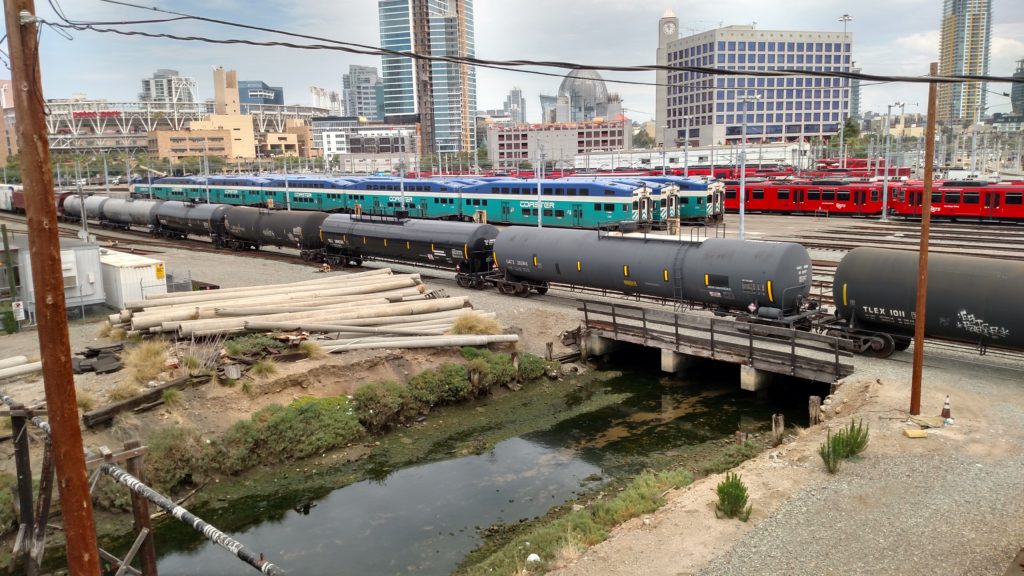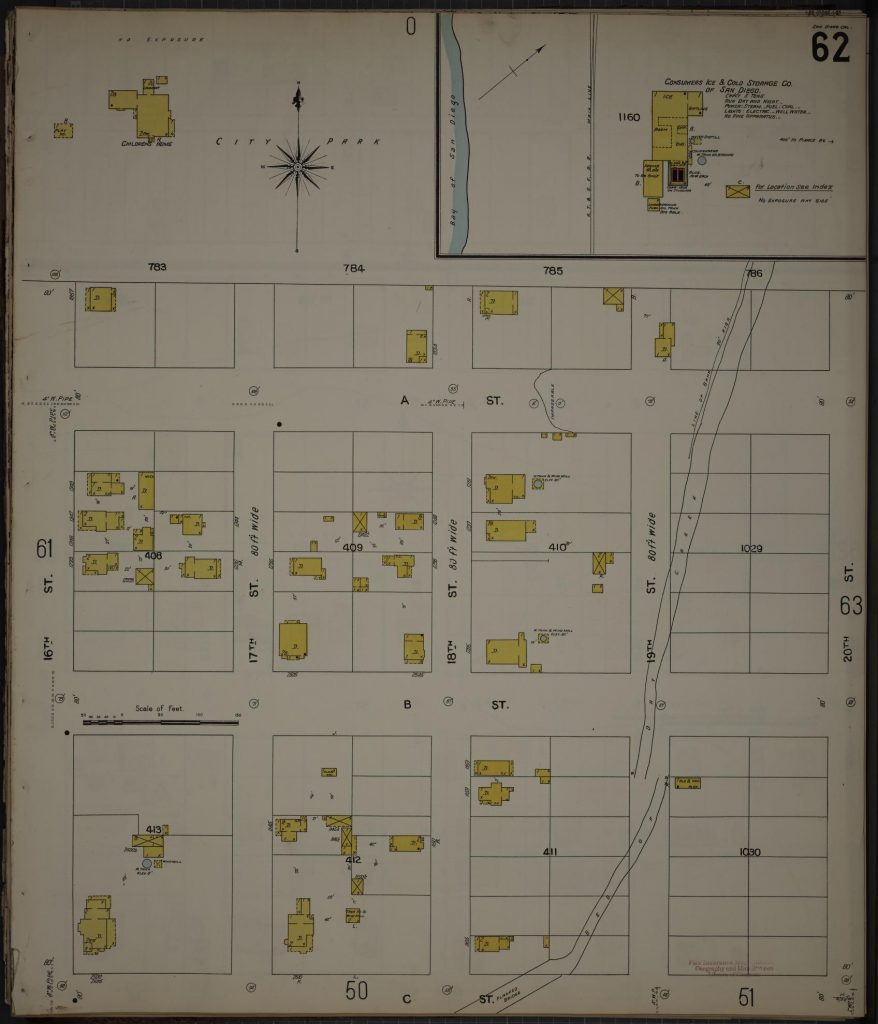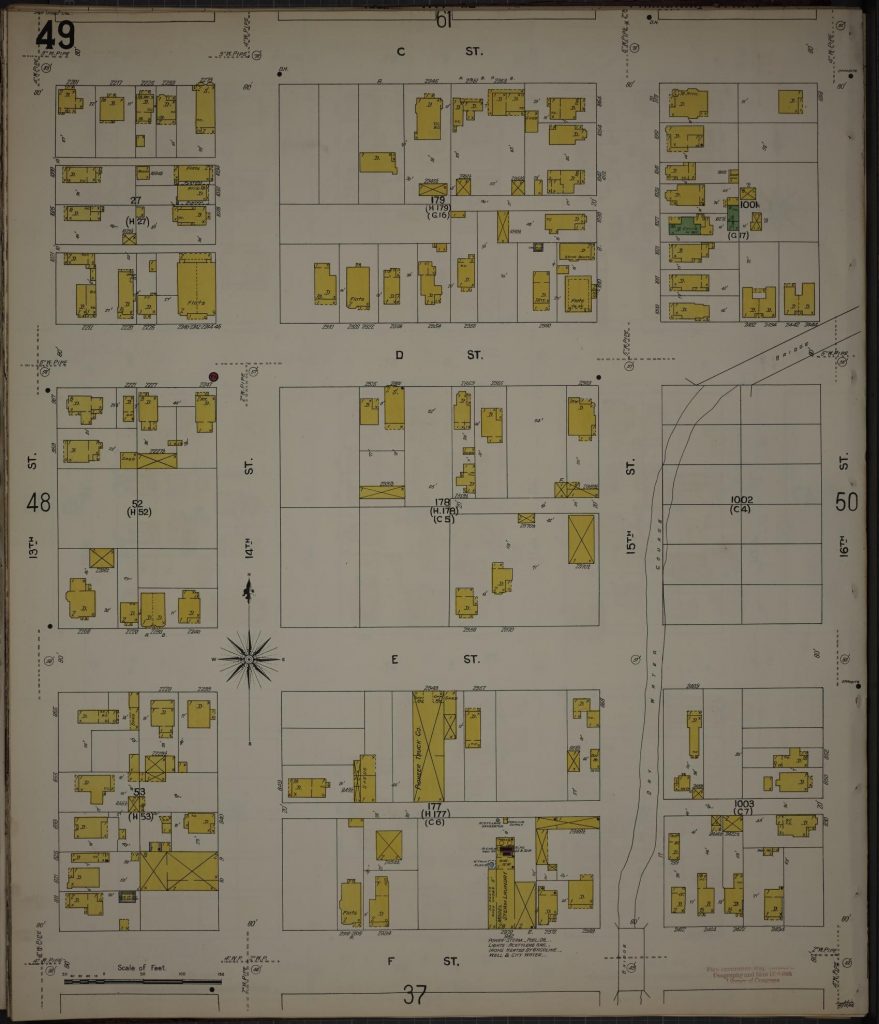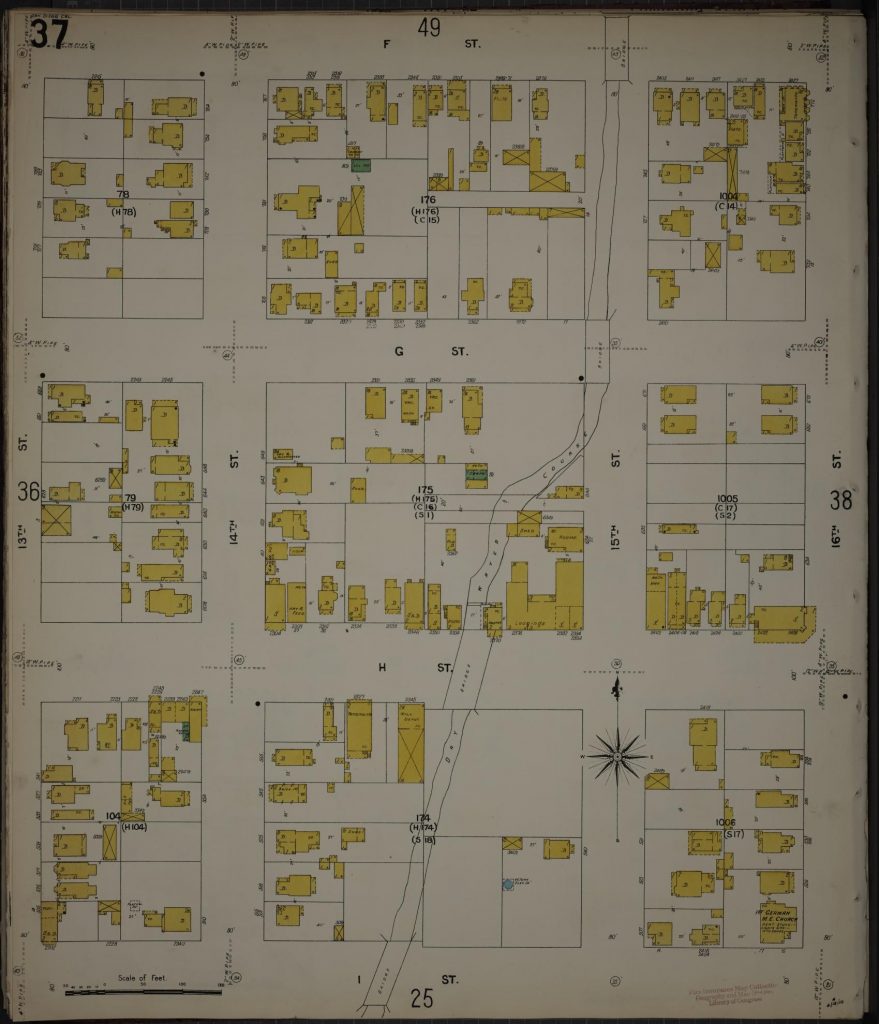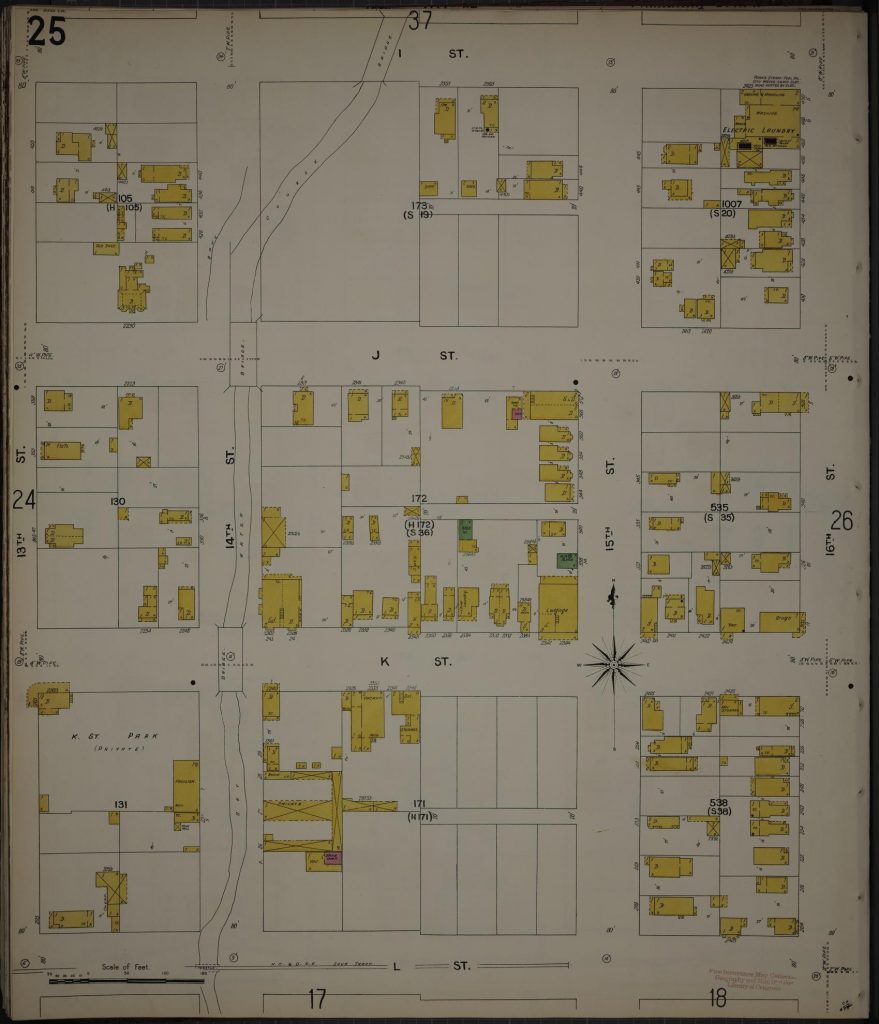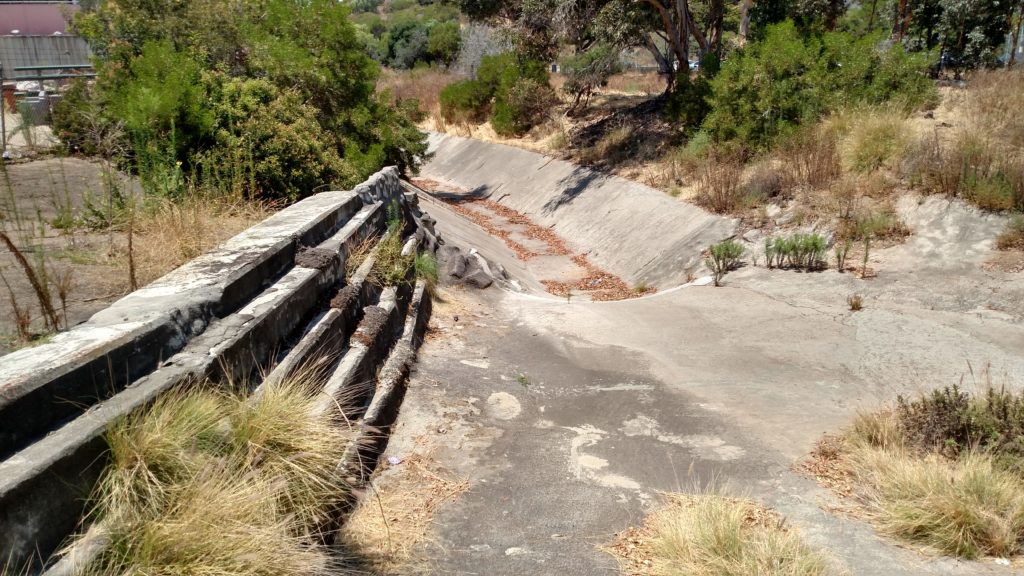
One of the natural geographical features of the area that became the city of San Diego was a seasonal stream that rose in the mesa east of what became Balboa Park. After flowing through the park the stream entered what is now the downtown area at 19th Street and ran in a generally southwesterly direction before emptying into San Diego Bay near what is now the 10th Avenue Marine Terminal. The stream became known as Switzer Creek, after a family that operated a farm on its banks near the southern boundary of Balboa Park, and the canyon it carved in the mesa east of the park is called Switzer Canyon. As San Diego’s population expanded eastward from the bay in the late nineteenth century city streets, including D Street (Broadway) and H (Market) Street, were extended across Switzer Creek over wooden bridges.
During San Diego’s summers Switzer Creek was normally dry, but winter rainstorms could send enormous amounts of water from its upstream catchment area to the channel running through the city. In January 1886 the San Diego Union reported that a cloudburst on the mesa brought a flood of water pouring down through ‘Switzer’s Cañon’ that ‘created consternation among the denizens of the low lands along Fourteenth Street from D Street well down towards the bay’, not a gradual rise but a ‘tumultuous body, with a roar that appalled and a force that tore up the soil and sand and carried boulders and everything before it’. The worst damage occurred at H Street, where a house carried away by the flood struck the H Street bridge, tearing it loose and washing it downstream. Another storm in December 1889 also washed away a small house in the vicinity of 14th and H streets. The house floated several blocks before colliding with another house which was loosened from its foundations but was too large to float away.
After several days of rainfall In January 1895 the bridges across Switzer Creek at C, D, G, I (Island) and J streets were closed, and some swept away, while the bridge at K Street was saved by several hundred sandbags piled along the channel to hold the stream in place. The bridge at H Street ‘continued strong’ during that storm, but by 1902 it had weakened considerably. The Superintendent of Streets reported that the job of repairing the H Street bridge between 14th and 15th streets turned out to be a more serious matter than thought as many of the direct supporting beams and braces were rotted almost in two.
In May 1906 the Board of Public Works recommended replacing the wooden bridges over Switzer Creek at D, F and H streets with concrete conduits, but only the H Street project was actually approved by the city council. Ordinance No. 2487 authorized a reinforced concrete conduit on H Street between 14th and 15th, provided the cost not exceed $5,847, and provided further that the San Diego Electric Railway Co. contribute $2000 to the cost of construction (a SDER streetcar line ran on H Street from the waterfront to 16th Street, then down 16th to Logan Avenue and Logan Heights). The contract was awarded to W. C. Jacobs and work began in July 1906. According to the San Diego Union, the new H Street concrete culvert, to take the place of the damaged wooden bridge, was planned to take care of all the water that will ever come down Switzer Canyon and ultimately to form part of a conduit extending the entire length of the creek bottom. It would be 102 feet long, 18 feet wide and 10 feet high, the form being that of a perfect arch, the crown of which will be about two feet below the street. Construction of the concrete culvert was completed by November but the fill dirt laid over it to bring the street up to grade was considered too damp and in need of additional time to become properly packed. H street was finally paved over the culvert in April 1907.
In January 1907 the city held a special election to approve a bond issue to pay for public works, including water mains, reservoirs, a road to Mt. Hope and a sewer system for La Jolla. The bond issue would include $50,000 to fund seven reinforced concrete culverts to be built under C Street at 18th, D at 16th, F at 15th, G at 15th, I between 14th and 15th, J at 14th, and K at 14th, replacing the old wooden bridges over Switzer Creek which had continued to deteriorate (the south half of the D Street bridge had been fenced off and declared unsafe for travel). The election was held on March 12 and voters approved the bond issue for culvert construction (they also approved the La Jolla sewer system, intended to end pollution of the ocean there and clear the way for the biological station which became the Scripps Institution of Oceanography and ultimately UCSD).
However, before any steps had been taken toward construction of the culverts, a group of citizens who owned property in the vicinity petitioned the city to consider a more comprehensive flood control proposal for Switzer Creek; a concrete conduit running all the way from 18th and C streets to the bay. This alternative would not just replace the wooden bridges but would enable the property owners to ‘fill up the creek and use its bed for building lots’. The $50,000 already approved for the culverts could be reserved and applied to the construction of the conduit. The council considered variations of this idea for over a year before finally passing a resolution in March 1909 authorizing the city engineer to prepare plans and specifications for a reinforced concrete culvert, running in the bed of Switzer Creek from the south line of the public park to the intersection of K and 14th street. Where streets then crossed the creek on wooden bridges, C Street at 18th, D at 16th, F and G at 15th, I between 14th and 15th and J and K at 14th, the full width of the creek bed would be graded to street level (E Street was not yet graded east of 14th Street and did not have a bridge). The project would also include a dam on the south line of the park to temporarily hold flood water that might exceed the capacity of the conduit.
The council advertised for bids for construction of the conduit project in May 1909 but when the bids were opened in June the lowest bid, by C. H. Julian, was nearly $61,000, exceeding the $50,000 that the city had on hand for construction. After considering whether to reopen bids or to award the contract to the lowest bidder on condition that a portion of the work be delayed until additional funds could be secured, the mayor recommended that the difference could be found in the general fund and the council decided that the contract should be let.
The normally dry creek was mostly private property and it required some time to secure right of way from the property owners but by the end of July work on the Switzer Creek conduit had begun. The San Diego Union reported in August 1909 that a large force of men under C. H. Julian were at work on the conduit which would extend from Switzer Canyon to the water front. The first stretch of the conduit was to be from E Street north past the C Street bridge and operations were then in progress in the vicinity of 15th and D streets, where the walls of the ditch were continually caving in and workers narrowly escaped being crushed and buried. Other men were tearing out the D Street bridge; after the conduit had been laid the gap would be filled with dirt to the level of the street. Cement workers had begun making sections of the huge concrete pipe for the conduit.
A story in the Union in September 1909 described the construction of the sections of concrete pipe. Each section was three feet long and five feet inside diameter. The concrete was reinforced with steel bands and rods, and was six inches thick, making the overall diameter of the conduit six feet. The sections were removed from their molds after one day but then waited fourteen days to be laid. The concrete contractor could make thirty sections a day. Sections were laid in the ditch by a steel derrick and connected with steel bands. After sections had been laid they were cemented, making a continuous pipe. This round reinforced concrete pipe would extend about a mile from the park to around I street; from I street to the bay the conduit would become a channel, ten feet wide and five feet deep, with greater capacity.
Contractor Julian had expected to finish the conduit within 90 days, before the normal beginning of the rainy season, but the project fell behind schedule and early in November he received permission from the council for an extension of time to complete the project. Changes in alignment and gradient were also approved by the council. By late November, however, the conduit had only been completed between the park and H Street, and a heavy downpour caused considerable damage below the completed section. A dam had been constructed at the lower end to prevent bay water from running back into the trench at high tide but instead floodwaters coming down the completed conduit were backed up by the dam and filled the trench, causing portions to cave in. Julian required another contract extension in January 1910 but by April the conduit had been completed and was accepted by the city.
C. H. Julian’s contract had required filling in the creek bed to street level where bridges had previously crossed the creek, but other sections of the creek bed would also be filled in over time. In April 1910, the same month that the conduit had been accepted, a contractor asked the city council for a permit to grade 15th Street from E to G streets by private contract at the request of nearby property owners. G. E. Gabrielson estimated that it would take a long time, 12 months or more, to complete the project because of the vast amount of filling that would be required. The fill dirt would come from street paving and basement excavations. Gabrielson added that property owners between D and E streets were also arranging to have the street graded in that block, which would open up 15th Street from D Street south. It had never been graded before because there was no conduit to carry off the flood waters of Switzer Creek.
Even with a conduit, the flood waters of Switzer Creek were not always carried off rapidly enough. In April 1926 a storm dumped about 3.2 inches of rain and caused an ‘avalanche of water’ emptying from Switzer Canyon and over the large dam there. According to the San Diego Union, the huge weight of water racing from the canyon threatened the Switzer dam and all available police and fire department reserves were rushed there. Below the dam the intersections were ’huge lakes into which poured roaring rivers’. This and other similar incidents led the city to build and maintain additional storm drains under city streets to add to the drainage capacity. In 1986, for example, the city budgeted $175,000 for replacement or restoration of the Switzer Creek storm drain system to ‘improve the flow of the aging network’.
In 2000 the San Diego Union-Tribune reported that city workers replacing aging water mains had stumbled upon what appeared to be a tunnel under the 1400 block of Market Street, an inverted U-shaped concrete and steel arch about 12 feet wide and 9 feet high with a dirt floor. A drainage pipe ran beneath the dirt floor and a variety of old items including bullets and bullet-riddled cans were recovered from what was evidently still open space under the arch. A 1909 city map found in a drawer at the city operations building was said to describe the subterranean structure as an arch of the Switzer Creek conduit. In all likelihood, the ‘Market Street tunnel’ was actually the concrete culvert built to replace the H Street bridge in 1906 (H Street was renamed Market Street in 1915), and the ‘drainage pipe’ was the Switzer Creek conduit, constructed in 1909. Once Switzer Creek had been diverted into the conduit, the bridges over which other streets had crossed the creek were replaced by dirt embankments, but at H Street the conduit ran through the existing culvert under the street and no fill was necessary. The culvert would have remained open and accessible and apparently was visited by local residents, some of whom used it as a shooting gallery.
In the 100-plus years since the completion of the Switzer Creek conduit, what remained of the creek bed has been filled in and the area developed, burying the H Street culvert and every other sign of Switzer Creek in the East Village area of San Diego. The creek still flows beneath the streets, however, and is ‘daylighted’ in a few spots around Harbor Drive before it empties into San Diego Bay. No longer considered a threat to flood areas of the city, it is monitored today for the pesticides, metals and other toxic substances that it may carry from the yards and streets of its catchment area into the bay.
